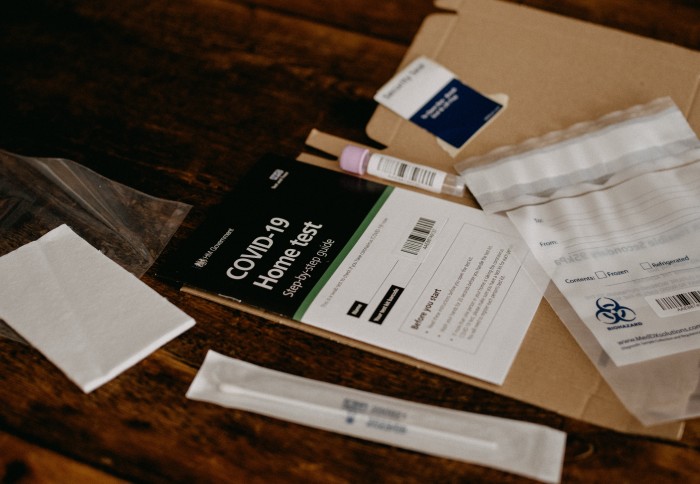Coronavirus infections have fallen substantially in England – REACT study

The number of people infected with the coronavirus in England has dropped by over two-thirds since January.
But infections are still high with around 1 in 200 people testing positive.
These latest findings from the REACT programme – the biggest study of community coronavirus testing – are based on swab tests taken at home by almost 85,000 people between 4th and 13th February.
"We need to all work to keep infections down by sticking to the measures which are designed to protect us and our health system." Prof Paul Elliott School of Public Health, Imperial
Infections have fallen across the country and several areas experienced a substantial decline, like London and the South East where five times fewer people are now testing positive compared to previous findings in January. However there are differences between regions and some areas have seen a smaller drop, such as Yorkshire and the Humber where infections fell by a quarter.
The prevalence of infection has also dropped across all ages, at a similar rate, suggesting the downward trends are due to lockdown rather than the impact of vaccination. The highest number of infections are occurring in young people aged 5 to 12 and 18 to 24, with around 1 in 110 testing positive in these age groups.
Professor Paul Elliott, director of the programme at Imperial, said: “These encouraging results show that lockdown measures are effectively bringing infections down. It’s reassuring that the reduction in numbers of infections occurred in all ages and in most regions across the country.
“While the trends we’ve observed are good news, we need to all work to keep infections down by sticking to the measures which are designed to protect us and our health system.”
These findings from the REal-time Assessment of Community Transmission (REACT 1) programme, carried out in partnership with Ipsos MORI, are available in a preprint interim report and will be submitted for peer-review.
The full report including tests on an anticipated 160,000 people in total is expected next week.
Calculating the R number
Out of 85,473 swab tests taken so far for this REACT testing round, 378 were positive giving an overall weighted infection prevalence of 0.51%, or 51 per 10,000 infected with the coronavirus. This compares with 1.57% or 157 per 10,000 in the previous round of testing, which ran from 6th to 22nd January. This means that a third as many people are currently testing positive as were in January.
"If this downward trend can be maintained, the pressure on the NHS will be greatly reduced." Prof Steven Riley Professor of Infectious Disease Dynamics, Imperial
The researchers estimated the national R to be 0.72 and that infections are halving every 15 days. This was calculated using data from this round and the end of the previous testing round in January.
R was found to be below 1 – meaning infections are shrinking – in almost all areas of the country except the North East which was around 1.
Professor Steven Riley, Professor of Infectious Disease Dynamics at Imperial, said: “The downwards trend in the most recent REACT data is good news. If this can be maintained, the pressure on the NHS will be greatly reduced, resulting in fewer hospital admissions and deaths.”
An R estimate for this round alone will be provided with the full report, which will include twice as many tests.
Trends in coronavirus infections
The prevalence of infection fell substantially since January in most areas of the country, from 2.83% to 0.54% in London, 1.66% to 0.33% in the West Midlands, 1.78% to 0.54% in the East of England, 1.61% to 0.30% in the South East, and 1.16% to 0.51% in East Midlands. The drop in Yorkshire and the Humber was smaller, from 0.80% to 0.61%.
"We must not drop our guard - cases and hospital admissions remain high." Matt Hancock Health Secretary
The North West and North East currently have the highest numbers of infected people, at 0.91% (down from 1.38%) and 0.82% (down from 1.22%), respectively.
Substantial falls in positive tests were also found across all age groups, with people aged 65 and above least likely to test positive (0.30%, down from 0.93%). This compares with young people aged 5-12 and 18-24, who have the highest infection prevalence at 0.86% (down from 1.59%) and 0.89% (down from 2.44%), respectively.
Health Secretary Matt Hancock said: “These findings show encouraging signs infections are now heading in the right direction across the country, but we must not drop our guard.
“While cases and hospital admissions remain high it is vital we all remain vigilant and follow the rules as our historic vaccination rollout continues at pace.
“I urge everyone to continue to stay at home – remember hands, face, space – and get your jab when you receive your invite.”
Understanding levels of infection in the community
The REACT 1 study is tracking current coronavirus infections in the community by testing more than 150,000 randomly-selected people each month over a two-week period. The study recruits new people each month to help ensure the sample represents the wider population and offers a high-resolution snapshot of the situation across a particular time period.
This is different from the ONS COVID-19 Infection Survey which runs continuously and samples the same people over time to understand household transmission. Because the studies use different methods, this means that sometimes they report different figures.
People who volunteer for REACT take throat and nose swabs at home, which are then analysed in a laboratory by a technique called RT-PCR. These findings are helping guide public health measures so that the Government can better respond to the pandemic as the situation evolves.
Article text (excluding photos or graphics) © Imperial College London.
Photos and graphics subject to third party copyright used with permission or © Imperial College London.
Reporter
Justine Alford
Institute of Global Health Innovation